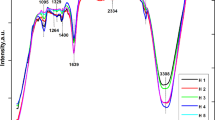Summary
We studied the effect of 7-isopropoxy-isoflavone (Ipriflavone) on the collagen synthesizing activity in human otosclerotic auditory ossicle samples from whole organ cultures during incubation for 96 h, and compared this effect with that found in normal meatal cortical bone. Ipriflavone led to a dose-dependent increase in the collagen synthesizing activity in both the healthy and the otosclerotic bone samples. At the highest Ipriflavone concentration used (50 μM), collagen synthesis increased 6-fold in the cortical bone and 9-fold in the otosclerotic bone, as compared with untreated controls. These findings indicate that the otosclerotic bone cavities are filled in vitro with organic matrix.
Similar content being viewed by others
References
Beretz A, Anton R, Stoclet JC (1978) Flavonoid compounds are potent inhibitors of cyclic AMP phosphodiesterase. Experientia 34:1054–1055
Beretz A, Stierle A, Anton R, Cazenave JP (1981) Role of cyclic AMP in the inhibition of human platelet aggregation by Quercetin, a flavonoid that potentiates the effect of prostacyclin. Biochem Pharmacol 31:3597–3600
Causse JR, Uriel J, Berges J, Shambough GE Jr, Bretlau P, Causse JB (1982) The enzymatic mechanism of the otospongiotic disease and NaF action on the enzymatic balance. Am J Otol 3:356–374
Chevance LG, Bretlau P, Jörgensen MB, Causse J (1970) Otosclerosis. An electron microscopic and cytochemical study. Acta Otolaryngol (Stockh) [Suppl] 272:1–44
Ferrell JG Jr, Chang Sing PDG, Loew G, King R, Mansour JM, Mansour TE (1979) Structure activity studies of flavonoids as inhibitors of cAMP phosphodiesterase and relationship to quantum chemical indices. Mol Pharmacol 16:556–568
Iyer PV, Cristwood RE (1984) Histopathology of the stapes in otosclerosis. Pathology 16:30–38
Nager GT (1969) Histopathology of otosclerosis. Arch Otolaryngol 89:341–363
Parahy C, Linthicum FH Jr (1984) Otosclerosis and otospongiosis: clinical and histological comparisons. Laryngoscope 94:508–512
Peterkofsky B, Diegelman R (1971) Use of a mixture of proteinase-free collagenase for the specific assay of radioactive collagen in the presence of other proteins. Biochemistry 10:988–993
Ribári O (1982) Medicamentous treatment of the otosclerotic process. Fül-orr-gégegyógyászat [Suppl] 28:95–100
Ribári O, Sziklai I (1983) Examination of noncollagen protein composition of the footplate and superstructure of the otosclerotic stapes. Acta Otolaryngol (Stockh) 95:580–584
Ribári O, Sziklai I (1984) Biochemische Veränderungen in otosklerotischen Gehörknochen und der Perilymphe. In: Majer EH, Zrunek M (eds) Aktuelles in der Otorhinolaryngologie. Thieme, Stuttgart New York, pp 28–31
Ribári O, Kiss JG, Tomity I, Jóri J, Stanzel Gy (1981) The effect of Ipriflavon (Yambolap) on the otosclerotic process. In: Surján L, Bodó Gy (eds) Proceedings of the XIIth World Congress, Budapest. Akadémiai Publishing House, Hungary, pp 547–549
Ribári O, Sziklai I, Kiss JG, Sohár I (1983) Cathepsin B activity in otosclerosis. Arch Otorhinolaryngol 238:123–125
Shambough GE Jr (1969) Sodium fluoride for inactivation of the otosclerotic lesion: present status. Arch Otolaryngol 89:381–382
Wong GL, Kocour BA (1983) Differential sensitivity of osteoclasts and osteoblasts suggests that prostaglandin E1 effects on bone may be mediated primarily through the osteoclasts. Arch Biochem Biophys 224:29–35
Author information
Authors and Affiliations
Rights and permissions
About this article
Cite this article
Sziklai, I., Ribári, O. The effect of flavone treatment on human otosclerotic ossicle organ cultures. Arch Otorhinolaryngol 242, 67–70 (1985). https://doi.org/10.1007/BF00464409
Received:
Accepted:
Issue Date:
DOI: https://doi.org/10.1007/BF00464409




